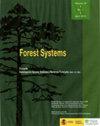解淀粉芽孢杆菌防治栎栎栎枯病的效果评价
IF 0.7
4区 农林科学
Q3 FORESTRY
引用次数: 0
摘要
研究目的:研究解淀粉芽孢杆菌对栓皮栎疫霉菌的生物防治潜力。通过体外和植物试验,评价解淀粉芽孢杆菌作为生物防治剂的有效性。 研究领域:微生物菌株,解淀粉芽孢杆菌和肉桂芽孢杆菌,以及所使用的Q. suber胚性系,都有西班牙起源。 材料与方法:体外实验通过双接种琼脂板,考察解淀粉芽孢杆菌对肉桂芽孢杆菌生长的抑制作用。在植物中,用肉桂假单胞菌和解淀粉假单胞菌共同接种植株进行了双重接种试验。生理参数,如光合活性,叶绿素含量和氧化应激标志物,进行了测量。所有实验均在受控条件下进行。 主要结果:体外实验显示了解淀粉芽孢杆菌对肉桂杆菌生长的抑制作用。受感染的植株表现出根部感染的症状。双接种试验结果表明,植物对肉桂霉的侵染均能存活。生理参数分析表明,不同处理和无性系之间存在差异,这突出了Q. subber植株对病原体的不同反应,并强调了遗传变异对疾病管理的重要性。 研究重点:本研究揭示了一株解淀粉芽孢杆菌作为一种生物防治剂在栓皮栎中对肉桂芽孢杆菌感染的潜力。需要进一步的研究来阐明不同克隆间的易感和抗性机制。本文章由计算机程序翻译,如有差异,请以英文原文为准。
Evaluation of Bacillus amyloliquefaciens as a biocontrol agent against oak decline disease in Quercus trees
Aim of study: This study aimed to investigate the biocontrol potential of Bacillus amyloliquefaciens against Phytophthora cinnamomi infection in Quercus suber (cork oak). Both in vitro and in planta experiments were conducted to assess the effectiveness of B. amyloliquefaciens as a biocontrol agent.
Area of study: The microorganism strains, B. amyloliquefaciens and P. cinnamomi, as well as the embryogenic lines of Q. suber used, have a Spanish origin.
Material and methods: In vitro experiments involved evaluating the inhibitory effects of B. amyloliquefaciens on P. cinnamomi growth through dual-inoculated agar plates. In planta, dual inoculation tests were performed by co-inoculating plantlets with both P. cinnamomi and B. amyloliquefaciens. Physiological parameters, such as photosynthetic activity, chlorophyll content, and oxidative stress markers, were measured. All experiments were conducted under controlled conditions.
Main results: In vitro experiments revealed the inhibitory effects of B. amyloliquefaciens on P. cinnamomi growth. Infected plantlets displayed symptoms of root infection. Dual inoculation tests resulted in plant survival against P. cinnamomi infection. Analysis of physiological parameters indicated variations among treatments and clones, highlighting the distinct response of Q. suber plantlets to the pathogen and underscoring the importance of genetic variability for disease management.
Research highlights: This study provides insights into the potential of a strain of B. amyloliquefaciens as a biocontrol agent against P. cinnamomi infection in cork oak. Further investigations are warranted to elucidate the underlying mechanisms of susceptibility and resistance in different clones of Q. suber.
求助全文
通过发布文献求助,成功后即可免费获取论文全文。
去求助
来源期刊

Forest Systems
FORESTRY-
CiteScore
1.40
自引率
14.30%
发文量
30
审稿时长
6-12 weeks
期刊介绍:
Forest Systems is an international peer-reviewed journal. The main aim of Forest Systems is to integrate multidisciplinary research with forest management in complex systems with different social and ecological background
 求助内容:
求助内容: 应助结果提醒方式:
应助结果提醒方式:


